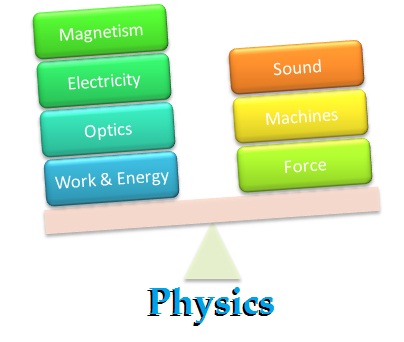What is Physics?
Physics is the study of Matter, Energy conversion and conservation of energy. All this are very deeply studied through intense research and practical work and the results are analyzed and published and the applications are used in day to day life.
Physics broadens its path in many applications such as communication technology, automobile industrial engineering and thermo-dynamic applications.

Let us study physics in detail under the following chapters
1. Force
2. Work and Energy
3. Machines
4. Optics
5. Sound
6. Electricity
7. Magnetism
8. Thermodynamics
9. Atomic physics
10. Plasma physics
11. Condensed state physics
Classification of Physics
The above chapters can be broadly classified under the study has:
1. Dynamics
2. Acoustics
3. Nuclear physics.
Dynamics: Dynamics is further divided into 2 parts namely
1. Statics
2. Kinematics
Statics: Statics deals with study of forces which are at rest.
Kinematics: Kinematics deals with the study of forces which are in motion.
Acoustics: The branch of physics which deals with the study of sound engineering and its applications.
Nuclear physics: Nuclear Physics deals with the study of creating atomic energy and its applications.
Physics Definitions
Let us start Physics with Some basic definitions:
Matter: Anything which occupies space is called Matter.
Displacement: When a body is displaced from one position to another position in a particular direction then it is referred as displacement.
Force: Force is a push or pull.
Vector quantity: The quantity which has both magnitude and direction is called a vector quantity. Example: velocity, force.
Scalar quantity: The quantity which has only magnitude but no direction is called a scalar quantity. Example: Mass, temperature.
Temperature: The degree of hotness or coldness is called temperature.
Velocity: The rate of change of displacement with respect to time is called Velocity.
Velocity = Displacement /time
Acceleration: The rate of change of velocity is called Acceleration.
Acceleration = Velocity /time
Uniform velocity: When the body travels equal distance in equal interval of time in a specified direction it is known as uniform velocity.
Non-uniform velocity: When the body travels unequal distance in equal interval of time in a specified direction or if it alters its change the direction of motion then its known as variable velocity.
Impulse: The sudden force that acts on a body is called Impulse. Example: The striking of a thunder.
Momentum: The product of mass time's velocity is called momentum. Example: motion of ball.
Momentum = mass * velocity.
Gravity: The mass of the body getting attracted towards the earth is called gravity. It is always denoted by g and its value is given by 9.8 m/s2.
So g = force/mass.
Work done: The displacement of the body after the application of the force is called work done by the body. Work done = force x displacement.
Energy: Energy is the amount of work done in a specified time.
Energy: Amount of work done/ time taken. It's measured in joules.
| Velocity | Kinematics | Gravitation |
Average Acceleration Calculator
Average acceleration is the object's change in speed for a specific given time period. ...
When an object falls into the ground due to planet's own gravitational force is known a...
In Mathematics, the permutation can be explained as the arrangement of objects in a particular order. It is an ordered...
A rectangle can be explained as a 4-sided quadrilateral which contains equal opposite sides. In a rectangle
A three sided polygon which has three vertices and three angles is called a triangle. Equilateral triangle...





